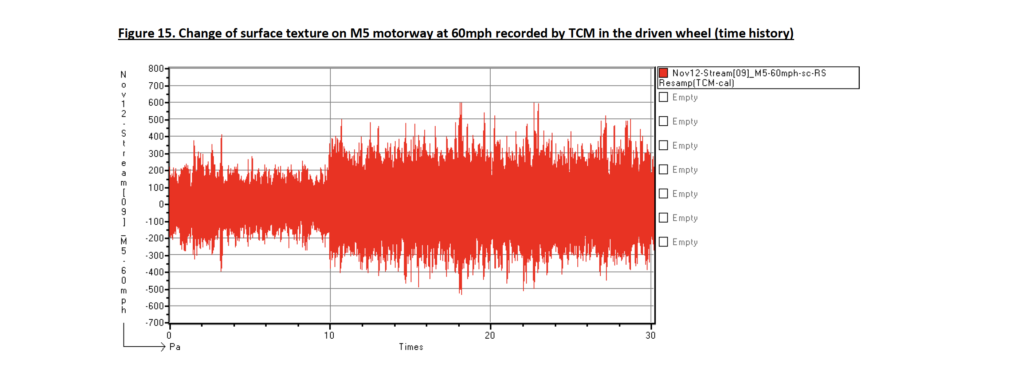A tire study has investigated if there can be a good agreement between rolling road and real road measurements.
Part 3: recap
The degree to which cavity resonances are excited, for any given tire, depends on the power being transmitted and the energy being input by the road surface texture and the tread pattern. The lack of a realistic road surface on most rolling roads means that test results from such smooth road wheels will not stimulate real road PCR tone levels. The on-road measurements, when compared with rolling road results, suggest that the road surface texture effectively spreads the energy over the spectrum.
Click here to read part three.
Effect of coarsely textured road surface and the impact of cat’s eyes
Sensitivity to noise in any environment depends first and foremost on the listeners ability to detect it. Humans, once they have heard, seen or smelt something, find it much easier to detect its presence should it occur again. If the thing being detected is judged as annoying, then the stimulus becomes an irritant and the subject’s reaction to it can become non-linear. This is the point we wish to avoid arriving at because what happens next is that news of this unwanted stimulus is communicated to the subject’s contacts who may pass on the ‘news’ via social networking. Who would knowingly buy a car with excessive road noise and/or a droning primary cavity resonance tone?
For most vehicles, cars and SUVs included, road noise and the PCR tone are currently masked by powertrain noise, but things are changing. Depending upon tread pattern and some other aspects of tire design, the PCR tone, which is always present, is not usually detected in the vehicle cabin at speeds <30mph (50km/h). However, should the tire be subject to a small impact, for example a cat’s eye or change of road surface texture, then the PCR may increase in level. This is the point that the driver may subconsciously or consciously catalog the PCR tone as tire noise and when it next appears, typically at around 50mph (80km/h), it will be immediately recognized. If it persists then the driver may complain and we may, if the next contact with the driver is handled badly, create a bad ambassador for our product.
Our test case is driving at 60mph (96km/h) on the M5 motorway and running over a short stretch of road surface laid to repair some damage. The change in the time history, as recorded by the TCM, is shown as Figure 15. The change is clear and quite dramatic, an approximate 150+Pa increase in peak level.
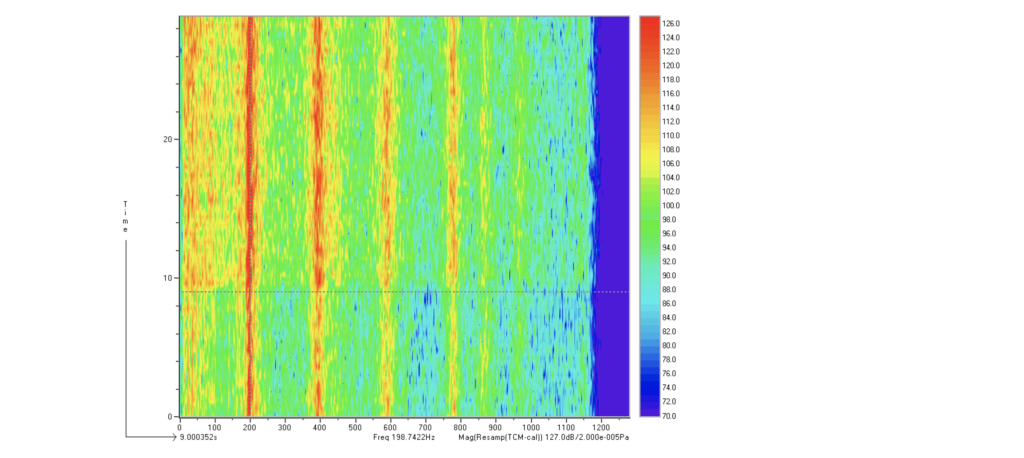
Processing of this recording (stream nine) to show the effect in the frequency domain gives us the color contour plot of FFT levels shown in Figure 16, where blue is 70dB and red is 126dB. Of note is the increase in the low frequency levels, between 10Hz and 220Hz, that occurred on the courser road surface. In previous project work it was found that a 7dB increase inside the tire brought a 7dB increase in the PCR tone level inside the vehicle’s cabin. The time history of four 1/3rd octaves each of which contain one of the first four cavity resonance modes and the overall level of the cabin noise is shown as Figure 17.
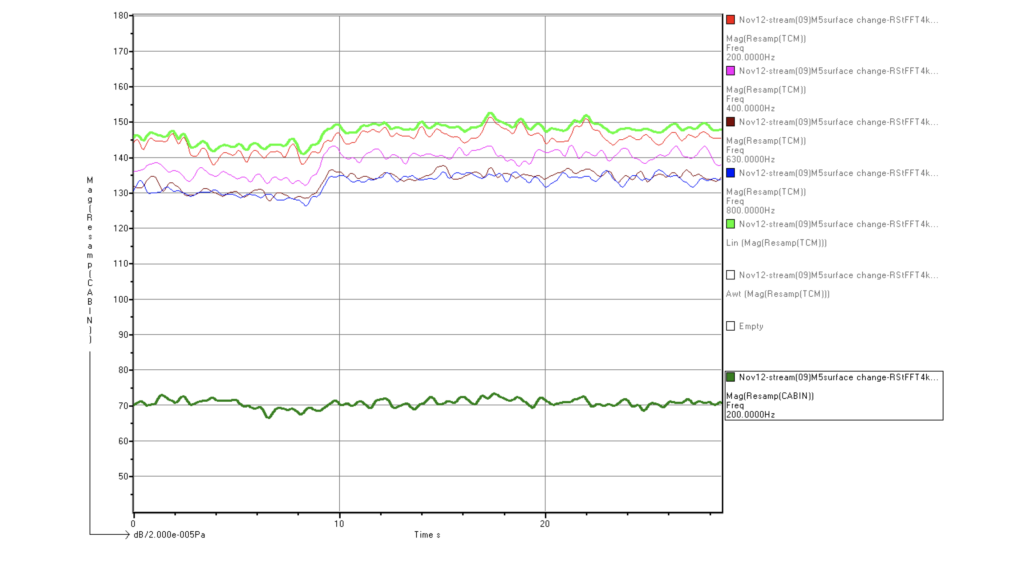
Inside the tire there is an 8dB step up in the overall level (light green line) and a similar step up in the PCR tone (200Hz third octave – red line). Such an increase if found in the cabin levels would significantly increases the chances of driver recognition. However, the surface change and consequent 8dB increase in SPLs seen in the tire did not cause any increase in the 200Hz third octave noise level in the cabin (dark green line), see Figure 17.
Impacts – cat’s eyes
Lane marking on UK motorways is reinforced by embedded reflectors, set into but protruding above the road surface. Historically these have been referred to as ‘cat’s eyes’ as they remind people of the way light is reflected back from the eyes of a cat at night.
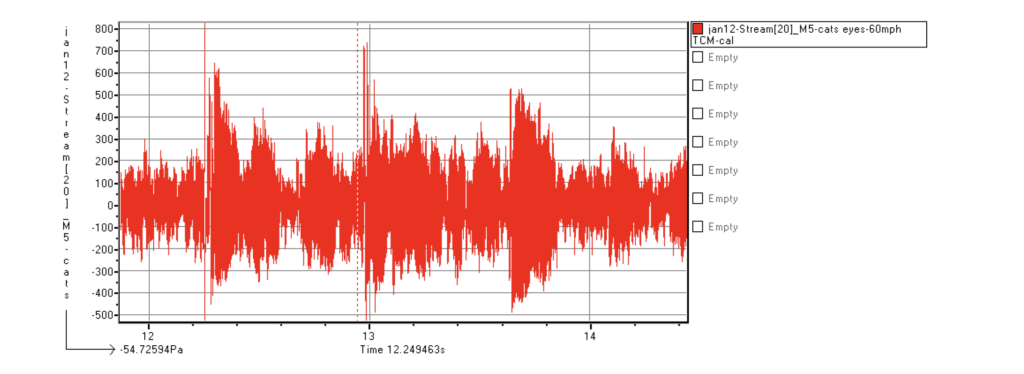
The time history trace (see Figure 18) shows the response measured inside the tire as a slow lane change was accomplished. The trace up to 12.20 seconds shows the normal SPL inside the tire at the same level as seen previously in Figure 15. At 12.25 seconds the front offside tire strikes a cat’s eye. Subsequent inputs cause the offside tire to make partial contact with cat’s eyes as the lane change progresses. At 13.6 seconds the offside tire again squarely hits the cat’s eye as the vehicle returns to the inner motorway lane.

Looking in more detail (see Figure 19) at the time history of the first cat’s eye impact (12.25 seconds) the response inside the tire’s cavity is at the PCR frequency, with the peak-to-peak amplitude going from +/-200Pa to +600/-300pa i.e. the amplitude more than doubled. The raised level did not persist for more than 75ms, too short a period for the vehicle occupant(s) to consciously notice the PCR tone should it have broken through.
Impact analysis is often better carried out using time/frequency or Wavelet analysis. Applying the Morlet wavelet to the cat’s eye impact reveals the dominance of the PCR as the response (see Figure 20).
Discussion
The cabin noise level of the truck at 65mph is 70dBA, which is 6dB higher than a luxury petrol engine passenger car at the marginally faster speed of 70mph. Allowing for the lower speed, the true difference between truck and luxury car might be as much as 9dB. The significance of low frequency noise (<200Hz) in the vehicle cabin is reduced when the A weighting curve is used (reference 1). The Linear weighted SPL for cabin noise at 65mph was on average 102dB. Such a level is likely to fatigue driver and occupants and mask any PCR tone that penetrated the cabin.
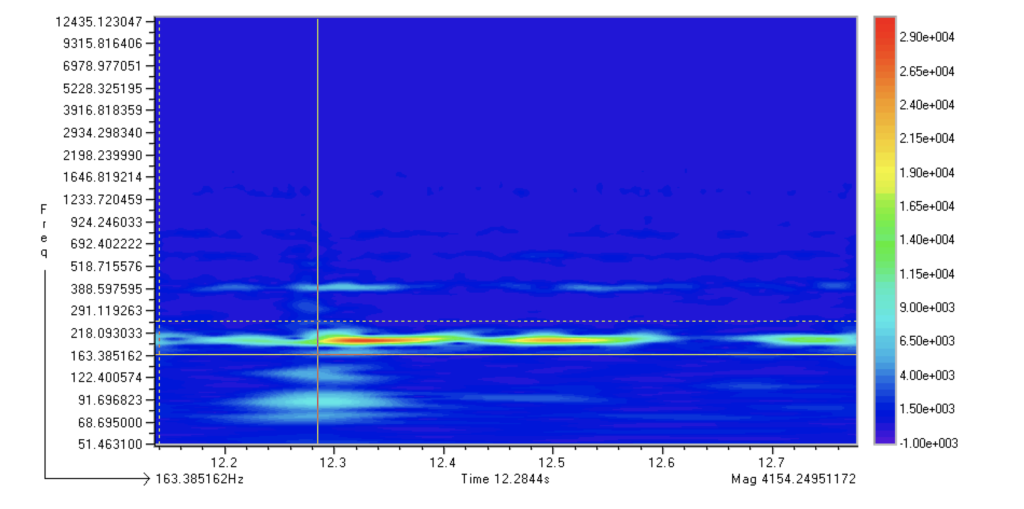
Conclusions
- Primary cavity tone intrudes into the typical car cabin when the in-wheel level exceeds 130dBLin. But may not be detected in the presence of loud powertrain noise.
- On most road surfaces at 65mph the low frequency noise and cavity resonances may be 10+dBLin higher than the levels measured in a test cell on a smooth steel road wheel.
- Tread design and tread compound can reduce tire cavity noise and the PCR mode levels by 7dB and possibly more. This 7dB reduction is the same as the reduction afforded by adding a sound absorbing acoustic foam band to the tire liner.
- The variation in measured in-tire levels when running on a selected road was never more than +/-2dB and usually +/-1dB. On-road testing can yield repeatable results.
- Driven wheel (DW) internal sound pressure levels increase rapidly as more power is transmitted. Putting PCR optimized tires on the driven wheels i.e. use acoustic foam inserts on the DW as the first priority.
- Undriven wheel (FW) internal sound pressure levels may plateau in level, for example 132dBLin for a wide band of speeds, for example 45-72mph, as in this study.
- Very high PCR levels can be initiated by a small impact, for example cat’s eyes, and may be sustained for 100ms.
- The development of a universal mapping that would enable the prediction of on-road in-tire SPLs from data derived from steel road wheel with an accuracy of +/-2dB will be difficult because tread pattern is a factor.
- Getting reliable and accurate (better than +/-2dB) on-road data for internal tire noise is easily achieved. Small changes in road surface and wet roads make little difference to internal tire noise.
*Indicated speeds were +3mph more than the actual speed reported by GPRS navigation. All speeds reported in this note are indicated speed. The TCM was always inside the Nokian tire, the tires moved from back on November 12 to front axle on January 12.


